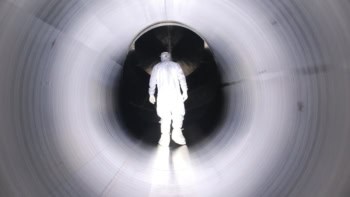The Large Hadron Collider could bring CERN huge rewards – but there are risks too

Anyone who is not a particle physicist is likely to look on in envy at the massive sums being spent on the Large Hadron Collider (LHC) at CERN. It has cost €1.8bn to build the machine’s accelerator, which will whip protons in opposite directions around a 27 km-long underground ring before smashing them together at energies up to 14 TeV some billion times a second. The four giant detectors – including the two general-purpose experiments CMS and ATLAS – have swallowed up several more billion Euros. Then there is the new Grid computer system, which is meant to analyse the vast streams of data spewing out from thee detectors every second. The total bill? A cool €6.3bn, give or take the odd bottle of champagne.
With a little over a year to go before the LHC collides its first beams together, the excitement at the Geneva lab is rising, as this special issue of Physics World reports. Some CERN staff have already been popping open the bubbly to celebrate various milestones being reached. Quite rightly too, as particle physics has been less than thrilling for the last 20 years, the discovery of the top quark and neutrino mass excepted.
But will the LHC be money well spent? Certainly building the new facility has been a magnificent achievement and an outstanding example of international collaboration. It promises to capture the imagination of the public and has inspired industry to overcome many technological hurdles, notably building the huge superconducting magnets that will steer the protons around the ring. Nevertheless, the LHC is still a massive gamble.
Finding the Higgs boson – the particle that is thought to endow all others with mass – would rightly be trumpeted by CERN as a huge success and would almost certainly lead to a Nobel prize. But its discovery would do no more than confirm the Standard Model of particle physics. What particle physicists are really banking on, given the limitations of that model, is evidence of “new” physics.
In particular, many are hoping to see evidence for “supersymmetry” – a symmetry that treats matter and force particles as two sides of the same coin and that could help to unify nature’s four fundamental forces. Its existence would be betrayed by a host of weird new supersymmetric particles. Unfortunately, there is no guarantee of that happening.
But the nightmare scenario is that physicists find nothing that has not already been seen at lower energies. It would force physicists to completely rethink the Standard Model and would almost certainly scupper the plans for the International Linear Collider (ILC) – a proposed machine designed to make precision studies of the Higgs boson. It would also put a question mark over CERN’s own blueprint for the ILC, known as CLIC.
Even if the Higgs pops out nicely from the data, CERN needs a carefully thought out plan to ensure that claims for it are not leaked by one team as it tries to trump another. There is already fierce rivalry between different groups – even between those on the same experiment – to get there first, and the last thing that CERN needs is a dirty priority battle fought out in the media. Still, if the LHC does all that it promises, particle physicists could be in for some vintage times and will deserve to crack open the champagne. But they should not get the bottles out of the fridge just yet.



